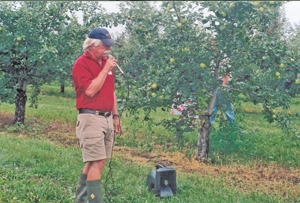
Features
Fruit
Production
Transferring apple varieties without an orchard replant
March 26, 2008 By Dan Woolley
In 1999, Annapolis Valley apple producer Craig Nicholls had a problem with colouring in a block of poorly performing McIntosh.
 |
| Bill Craig, a tree fruit specialist with Agra Point International, comments on the replant work done by Nova Scotia apple producer Craig Nicholls. Nicholls re-grafted an entire block of his orchard from McIntosh to Honeycrisp. It was a stop on a recent tour of the Nova Scotia Fruit Growers’ Association. Photo by Dan Woolley |
In 1999, Annapolis Valley apple producer Craig Nicholls had a problem with colouring in a block of poorly performing McIntosh.
Instead of ripping the entire section of orchard out, Nicholls decided instead to keep the M1-11 rootstock and graft the entire block over to Honeycrisp. He grafted up to 10 scions on each rootstock – four on the top and the other six laterally – on the ends of limbs he had cut back.
In 2002, he decided to transfer another McIntosh block to Honeycrisp. This time, however, he saved himself a lot of labour by using far fewer scions – just two to four on top of each rootstock.
By concentrating on the leader grafts of this second block, Nicholls harvested a first crop of apples only four years after grafting over.
He cut back the nurse limbs in the second block two years after grafting the block in a bid to control the vigor on the grafts.
“We don’t over-fertilize either,” Nicholls explains. “Once you get a crop on it, you can give it an extra push. But you don’t want to overdo it.”
Bill Craig, a tree fruit specialist with the consulting firm Agra Point International, believes Nicholls’ orchard offers this message: “You can retain existing rootstock and, through grafting new varieties, get back into production much faster than by replacing the block.”
Nicholls also planted new Honeycrisp seedlings between the grafted rootstocks in his first block. They did not develop as he had expected, so he decided to graft only on the second block’s rootstock.
Since that block’s grafts developed much faster than he anticipated; Nicholls felt there was no need to replant seedlings between the second block’s rootstocks
Print this page